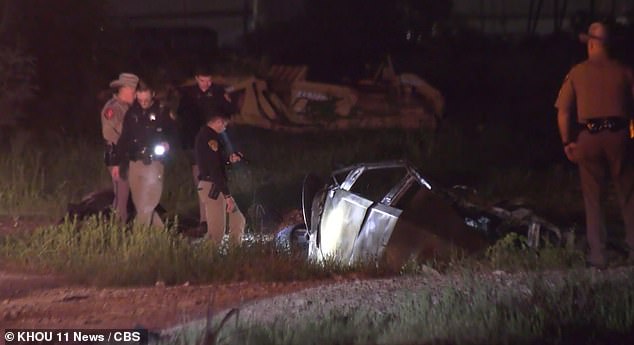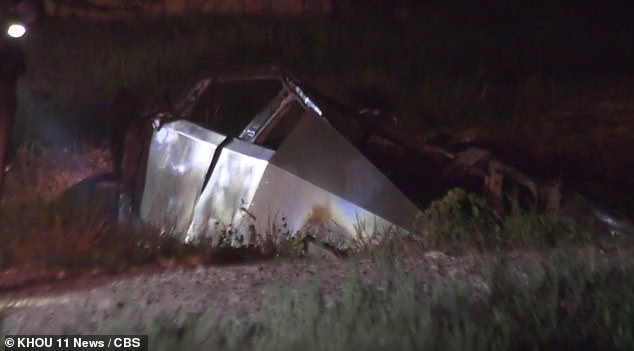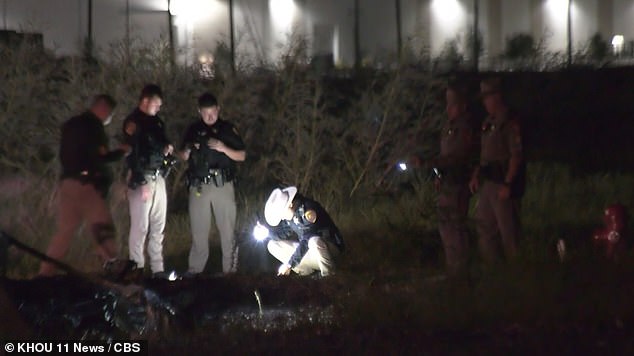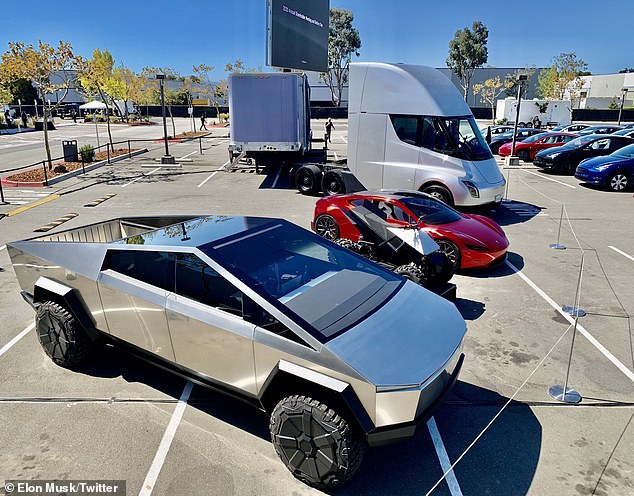First fatal Tesla Cybertruck crash kills Texas man after electric car veers off road for ‘unknown reason’ – as police investigate possible safety flaws
A raging battery fire has burned a Tesla Cybertruck owner alive off the East Texas coast, in what is believed to be the first fatal accident involving the new electric vehicle.
Police reports show the deadly incident happened just outside Houston at 1:45 a.m. local time on Monday.
According to government officials, the trendy but battered electric car burst into flames after it crashed into a concrete drainage channel, or culvert. The truck’s license plates and VIN number were no longer recognizable.
In addition to local authorities, the federal National Highway Traffic Safety Administration (NHTSA) is also investigating the cause of the fatal incident.
A raging battery fire has burned a Tesla Cybertruck owner alive just off the west coast of Texas (above), in what is believed to be the first fatal crash for the new electric vehicle
The episode is just one of many harrowing stories about safety lapses in the Cybertruck, which Tesla CEO Elon Musk once described as “apocalypse-proof” despite the fact that the electric car has been recalled no fewer than four times since its debut in late November 2023.
While traveling west on Cedar Parkway in the Baytown area, the now-burned Cybertruck veered off the road into what authorities believe was a local CBS station. KHOU 11 as ‘an unknown reason.’
Loyal fans of the Tesla EV at the Cybertruck Owners Club An online forum opposed the reporting, with one saying: ‘Are they going to report on the hundreds of car fires a day in the US or just Tesla?’
“1:45?” another user asked. “That’s all I need to know.”
However, scientists and auto safety experts have drawn attention to the unique thermal power of lithium-ion batteries when surrounded by the flames of a runaway chemical reaction.
“Battery powered vehicles account for a small portion of car fires, but controlling electric car fires is difficult,” said Dr. Apparao Rao, physicist at Clemson University and his colleagues recently explained this in an essay on the issue.
A typical burning battery in an electric car burns at a temperature of about 2,760 degrees Celsius (5,000 degrees Fahrenheit), half the temperature at the surface of the sun.
Most metals, including platinum, titanium, and the Cybertruck’s stainless steel, melt at temperatures below 2,600°C.
According to Dr. Rao, in an emergency, it would take 20,000 gallons of water to extinguish a fire in an electric car battery of this size, 10 times more than what would be needed to extinguish a normal fire in an internal combustion engine car.
A fire in a gas-powered vehicle, he and his fellow researchers wrote for The Conversation, only starts at temperatures up to 1,500F (815C).
Texas authorities said the driver of the Cybertruck could not be identified because of severe burns from the metal-liquefying temperatures. His $81,000 electric truck was engulfed in flames.
Although the federal National Transportation Safety Bureau has previously led the Tesla crash investigation, the agency told local news that it had not yet been contacted for assistance in the case.
But sister agency NHTSA, which focuses more on defects in the vehicles themselves, told reporters it wants more information from Tesla about defects in the Cybertruck that may have led to Monday morning’s deaths.

Texas state safety officials (pictured) said the trendy but battered electric car burst into flames after it crashed into a concrete drainage ditch, or culvert, leaving the owner’s body and even his truck’s license plates and VIN number hidden from the crowd of other vehicles.

In addition to these local authorities, the federal National Highway Traffic Safety Administration (NHTSA) is also investigating the cause of the fatal incident (above)

A typical fire in a runaway battery in an EV burns at a temperature of about 5,000 degrees Fahrenheit (2,760 degrees Celsius) – half the temperature of the surface of the sun. Most metals, including platinum, titanium and the stainless steel of the Cybertruck itself, melt below 5,000 degrees Fahrenheit
Over the past year, Musk has promoted his company’s Cybertruck as a sustainable, even Mars-capable space exploration vehicle.
The tech billionaire put the electric car through its paces in several high-profile demonstrations, including shots fired from a Tommy gun, a 45mm and a 9mm pistol.
In late 2023, shortly after the Cybertruck’s launch, Tesla CEO challenged comedian and podcaster Joe Rogan to attempt to pierce the electric car with an arrow.
“Can I shoot it with an arrow? I bet I can get in,” Rogan said during the 2054th episode of The Joe Rogan Experience.
Musk responded with a laugh, “Yeah, it’ll be fine.” (Eventually, (The tip of the arrow struck the Cybertruck, but failed to penetrate.)
However, there is criticism of the unusually designed and angular electric car. According to him, the design would be more important than safety. This is evident from the sharp edges of trunks and doors that can injure human fingers and other body parts.

A Tesla Cybertruck parked next to several other vehicles
Last April, Tesla has temporarily halted all Cybertruck deliveries referring to reports that the vehicle’s accelerator pedal could easily become stuck at full speed, a discovery that led to the recall of nearly 4,000 Cybertrucks.
But as auto reporter David Tracy told local news, battery-powered electric cars are no more susceptible to fire than conventional gasoline-powered cars.
“When we look at flammability, the chances of electric cars catching fire are not that great,” Tracy said.
AutoinsuranceEZ, based on public data from the NTSB, found that all-electric vehicles are the least likely to catch fire, followed by gasoline-powered vehicles.
Their research found that hybrid gas-electric vehicles caught fire most often.
“My sincere condolences to the family of whoever was in that vehicle,” Tracy added.
